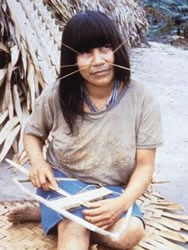Matses in Peru

Photo Source:
Instituto Lingüístico de Verano
|
Send Joshua Project a map of this people group.
|
| People Name: | Matses |
| Country: | Peru |
| 10/40 Window: | No |
| Population: | 5,500 |
| World Population: | 6,400 |
| Primary Language: | Matses |
| Primary Religion: | Ethnic Religions |
| Christian Adherents: | 5.00 % |
| Evangelicals: | 0.20 % |
| Scripture: | New Testament |
| Ministry Resources: | Yes |
| Jesus Film: | Yes |
| Audio Recordings: | Yes |
| People Cluster: | Amazon |
| Affinity Bloc: | Latin-Caribbean Americans |
| Progress Level: |
|
Introduction / History
The Matses first encountered Westerners around 1621, when epidemics began to greatly reduce the population. Over the next several centuries, they suffered much violence and cruelty at the hands of outsiders and other tribes, and they reacted with extreme violence and a reputation for kidnapping non-Matses women to be their wives. In the 1960s, the Peruvian government, frustrated with the Matses resistance, bombed a few Matses settlements with Napalm. However, in 1973, Peru created a territorial reserve for the Matses people.
In 1969, Summer Institute of Linguistics (SIL) missionaries learned the language, made contact, and began to live among them. Weary of fleeing from outsiders, the Matses abandoned their former way of violence. SIL completed the translation of the New Testament in 1993, and the Word of God made a profound impact upon the Matses people. Since then, SIL has partnered with other mission agencies to host Bible teaching conferences. There are now Matses pastors, health promoters, a dentist, teachers, and tradesmen like carpenters and mechanics.
Each Matses community in Peru has a self-sustaining church, and believers are eager to learn the Word of God and apply it to their lives. They also have a vision for reaching the Matses people in both Peru and Brazil.
Where Are they Located?
The Matses live along the Peru-Brazil border on the Yaquerana, Yavari, Galvez, and Blanco Rivers.
What Are Their Lives Like?
The Matses live an agrarian subsistence lifestyle based on farming, hunting, and fishing. Principal crops include manioc, plantains, maize, sweet potatoes, and various fruits. The Matses are renowned for their skill in the hunt, since they live in a remote area of the Amazon where game still abounds. Though they used to hunt with blowguns, today they prefer the bow and arrow. Women accompany men in the hunt, and men use bitter substances like frog venom, tobacco snuff, bullet ant stings, and plant sap to increase their ability to see and kill prey.
The Matses are still functionally monolingual, primarily relying on the Matses language for their day-to-day lives. Traditionally, the Matses lived as extended families in one long house with a door on each end decorated with the skulls and bones of monkeys and other animals they had killed. Today, they live in small houses as individual family units.
Matses culture is a blend of traditional and modern values. Formerly, they had a line tattooed around the lips and across both cheeks to the ear, finished with bristles that stuck out of the nostrils or upper lip. Matses garb has mostly been replaced with Western clothing, but other traditions remain. In order to marry, men must pay a bride price of prestigious modern items, such as rifles, wristwatches, or radios and work for their father-in-laws for a period of time. Women make hammocks and cooking pots for their families.
The Matses are used to egalitarian decision making through community discussion. While they now have individual political leaders in each community, their power is not always respected if the leaders contradict what the people want.
What Are Their Beliefs?
The Matses hold to animistic views that seek to discover spiritual causes for life problems and resolve them through shamanistic rituals. They believe that the cosmos is made of many overlapping worlds that can be perceived and navigated by the shaman, who functions as a helpful bridge between the material and the spiritual worlds. Because mysterious evil spirits abound, often hidden behind ordinary plants and animals, the shaman must enter into contact with the spirit world and discover both causes and solutions to problems like death, illness, and hunger. Even some Christians continue to seek out the shaman during times of crisis.
Matses culture is split into a dualism between tsasibo (ferocious individualists, modeled after jaguars) and macubo (collectivists, modeled after larvae) types. Everyone is identified as belonging to either the tsasibo or macubo designation and receives the facial markings and distribution of labor that accompanies their type. Marriages are most often unions between a tsasibo and macubo, demonstrating the interdependence of the two groups.
Because they believe that the spirits of plants and animals have great power, the Matses have many food taboos, like what kinds of food and animals new parents must avoid consuming or touching to avoid bringing harm to infants.
What Are Their Needs?
Matses believers are asking for more biblical training, as their understanding of Scripture is still quite simple. Apart from the gospel, they do not know much about the Bible, and the majority do not have the opportunity to learn.
The Matses also need regular life-on-life discipleship, since most church members are expected to grow primarily through listening to sermons at church.
Because of their remote location, the Matses do not have any professional healthcare, and they often die from preventable illnesses like hepatitis. They need basic medicine and access to healthcare.
Prayer Points
Pray that God would call and send more missionaries who will devote themselves to discipling Matses believers.
Pray for the Matses' healthcare and physical needs.